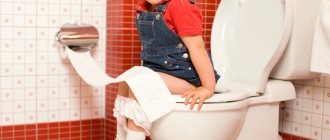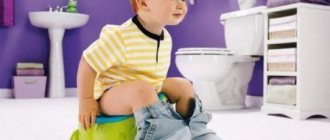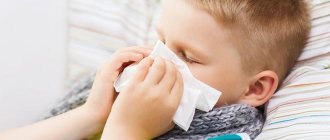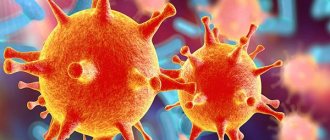Unpleasant disorder - the child has loose stools with mucus
Loose stools, or, as it is also called, diarrhea, is a fairly common and unpleasant phenomenon that happens in the life of every person.
Diarrhea often occurs in children. Repeated bowel movements cause a lot of discomfort for babies. If a child has loose stools with mucus, this may indicate an infectious nature of the disease.
Often, blood or fatty inclusions may be released along with mucus. Such disorders can occur in both acute and chronic forms.
What causes indigestion
If bowel movements occur with a large amount of water and mucus inclusions, this indicates an acute intestinal infection.
The child’s body tries to cleanse itself of bacteria by removing water mixed with salts from the intestines.
In the warm season, the bacterial form of diarrhea is common, while in the cold season, its viral variety is common.
This type of intestinal disorder is dangerous due to dehydration. It is necessary to give your baby water to replenish fluid reserves in the body.
Diseases that cause diarrhea
Normally, children have bowel movements once a day, and the consistency of the stool should be moderately thick, and the color of the excrement can vary from yellow to light brown. With diarrhea, loose stools are observed, and in some cases with mucus.
The main causative agents of diarrhea with mucus are:
- salmonella;
- Giardia;
- cryptosporidium;
- rotaviruses;
- enteroviruses;
- enteropathogenic coli;
- enterotoxigenic coli.
The causes of diarrhea with mucus can also be:
- enterocolitis;
- gastroenteritis;
- lactose deficiency;
- individual intolerance to cow's milk.
In some cases, diarrhea can be caused by emotional stress and stress.
One of the reasons for the appearance of diarrhea with mucus in a child may be an unbalanced diet. In addition to the visible symptoms of the disease, the child may experience nausea, loud rumbling in the intestines, poor health, lethargy, weakness, fatigue, nervousness and irritability. In some cases, these symptoms indicate IBS - irritable bowel syndrome.
This phenomenon may be associated with increased excitability of a fragment (or several sections at the same time) of the digestive tract.
Under normal conditions, food moves evenly at the same speed down the intestines.
With IBS, the speed in certain parts of the intestine may change: slow down or increase. This leads to discomfort in the abdominal area. This disorder is usually accompanied by pain and cramps, diarrhea or constipation.
The reasons for the abnormal speed of movement of the digestive tract may be:
- Increased activity of the nerve endings of the child’s digestive tract. Stress and emotional disturbances can trigger the onset of IBS.
- The presence of infection or bacteria in the body. IBS can appear against the background of developing gastroenteritis, which can cause diarrhea or vomiting.
- Long-term use of antibiotics. With prolonged use of antibiotics, a number of beneficial bacteria necessary for the stable functioning of the gastrointestinal tract die in the intestines. A lack of these bacteria can lead to the development of irritable bowel syndrome.
A distinctive feature of diarrhea with mucus from bloody diarrhea is the frequency of the urge to defecate and pain during defecation. With this disease, the large intestine is affected. The causative agents may be E. coli and dysentery.
When suffering from dysentery, the stool contains inclusions of bloody streaks on greenish lumps. When the body is infected with salmonella, green or orange mucous flakes are found in the stool.
Features of the treatment of mucous diarrhea in children
Timely diagnosis and correct diagnosis allows you to get rid of diarrhea in the shortest possible time and without complications.
Only an experienced doctor should treat a child, after conducting all the necessary studies and tests.
Treatment for mucous diarrhea can be a regular diet or drug therapy (depending on the form and course of the disease).
If signs of diarrhea are detected in a child, you should immediately stop feeding him. It is necessary to give the child only plenty of fluids. The ideal option in this case is still mineral water.
If you don’t have mineral water on hand, you can prepare it at home. To do this, dilute a tablespoon of sugar and salt in 1 liter of warm water. Mix everything thoroughly until the crystals are completely dissolved.
It is necessary to give the child this solution throughout the day, half a glass at a time.
If the child’s weight does not begin to decrease sharply, then there is every reason to believe that diarrhea is a sign of food poisoning. In this case, gastric lavage and a limited diet for 1-3 days are recommended. Heavy, fried and fatty foods are excluded from the menu.
The diet includes porridge, light soups and jelly. It is better to cook porridge with water, but it is recommended to temporarily exclude milk from the diet.
In small quantities you can give: bananas, baked apples, biscuits and crackers.
Vegetables allowed include potatoes, carrots and broccoli - all only in boiled form.
It is better to serve food in a pureed state - this way it will be easier to absorb in the body. During treatment, sweets, baked goods, chocolate, ice cream and soda should be excluded.
To restore the water-salt balance, you can use the drug "Regidron", strictly following the instructions for use of the drug and observing its dosage.
To reduce the effect of toxins on the child’s body, it is recommended to give the baby activated carbon at the rate of 1 tablet per 10 kg of weight.
After each bowel movement, hygienic water procedures should be carried out in order to prevent irritation and redness on the skin.
If loose stools are accompanied by elevated body temperature, you should immediately consult a doctor. These symptoms indicate an intestinal disease and require diagnosis. Self-medicating in such a situation is extremely dangerous, since the cause of diarrhea can be a completely different disease. And diarrhea here is just one of the unpleasant symptoms.
Causes of diarrhea with mucus with fever:
If the body temperature rises to 38.5°C or higher, it is necessary to give the baby antipyretics.
Diagnostics
Tests to determine the cause of diarrhea with mucus:
- A general blood test will help determine the degree of danger of infection and the strength of the inflammatory process occurring in the body.
- Coprogram. This is a study aimed at identifying failures of enzymatic systems. The work of the pancreas is reflected here, the form of the inflammatory process in the gastrointestinal tract is determined.
- Bacteriological analysis of stool. Using this analysis, the bacterium that is the causative agent of the disease is determined. In this way, diseases of staphylococcus, klebsiella, and enterococci can be detected. In the same study, the presence of dysbacteriosis is determined by sowing the amount of beneficial bifidum and lactobacilli contained in the child’s feces. The main disadvantage of this method is its completion time – 5-10 days.
- Fecal analysis for helminthiasis. This includes testing for worm eggs.
- Stool culture for dysentery group. The test is taken to confirm or refute infection with dysentery.
- Culture for staphylococci and rotaviruses. Performed at the request of the attending physician.
Based on the test results, the doctor will prescribe adequate treatment.
To restore normal intestinal function, probiotics are prescribed.
Probiotics are a broad group of medications containing strains of live bacteria.
They restore the natural intestinal microflora, thereby improving its functioning.
During the course of the disease, it is not recommended to visit kindergartens or nurseries until complete recovery, since the body is weakened and more susceptible to viral and infectious diseases. Walking with your child outside will be useful. You need to take walks at least 2-3 times a day.
During the course of the disease, it is better to prohibit the child from contacting pets in order to reduce the risk of re-infection of the still weakened child’s body.
To avoid emotional stress and stress, it is advisable to limit your viewing of cartoons and TV shows. It is important to maintain a sleep schedule. It wouldn't hurt to take a course of vitamins. They will help the body recover faster after a serious illness and loss of microelements.
Diarrhea mixed with mucus in children can be caused by a variety of factors. For a correct diagnosis and correctly prescribed treatment, it is necessary to show the child to a doctor.
Source: https://momjournal.ru/zdorove-rebenka/detskie-bolezni/u-rebenka-zhidkij-stul-so-slizyu.html
Treatment of diarrhea
To make an accurate diagnosis, a specialist prescribes a blood, urine, and stool test. Depending on what causes the indigestion, it is necessary to select medications to treat diarrhea.
For any disorder of the digestive tract in a child, comprehensive treatment is necessary. Required:
- Restoring the level of salts and fluids in the body . For this, rehydration solutions are used (Humana Electrolyte, Regidron). Taken in large volumes for diarrhea with mucus in a child, as soon as the first signs of the disease appear. If there are no pharmaceutical medications, prepare a home rehydration solution: in chilled boiling water (500 ml), 2 teaspoons of salt and sugar, 0.5 teaspoon of soda.
- Removing intoxication . Enterosorbent agents for diarrhea are used: Activated carbon, Enterosgel, Smecta. Adsorbents are consumed between meals.
- Restoring the balance of intestinal microflora . Young patients are prescribed Bifidumbacterin, Bifiform. Especially if the cause of indigestion is dysbiosis. These drugs can also be given to prevent digestive upset when using antibiotics.
- Antimicrobial therapy . The antimicrobial drug Stopdiar or its analogues is suitable for the treatment of infectious diarrhea in children.
- Antibacterial therapy . Antibiotics are taken under the supervision of a doctor. If a child has green diarrhea with mucus due to a bacterial intestinal infection, he may be prescribed injections of Cefatoxin and Gentamicin.
Since green diarrhea with mucus often indicates the development of a rotavirus infection, a pediatrician can prescribe antiviral medications to a sick child.
In any case, before giving medications to the baby, parents should definitely consult a doctor. Only a specialist can select a set of drugs that quickly and safely eliminate diarrhea with mucus in an infant.
Diarrhea with mucus in a child: causes and treatment
Diarrhea with mucus in a child is often accompanied by panic in the parents. In a desire to help the baby, they begin independent treatment. At the same time, mistakes are often made that complicate the patient’s condition and can mask a dangerous disease.
The best option is to understand the causes of diarrhea, provide the right help and consult a doctor.
Mucus is a natural substance in the digestive tract.
It is produced by goblet cells, which are located on the surface lining of the intestine.
The function of mucus is to moisturize and protect the internal surfaces of the intestines, improve the movement of food mass (chyme) and the breakdown of nutrients. The viscous mass is always excreted in small quantities in the feces, but is normally invisible.
Mucus becomes visible when there is excessive secretion into the intestinal lumen. It looks like a gel-like mass that can be transparent, red or green.
This occurs when there is spasm or inflammatory damage to the lining of the large intestine. At the same time, blood and pus may also be released in the stool.
Why does a child develop diarrhea with mucus? After damage to the mucous membranes, protein is released (exuded), water and electrolytes are “dumped” into the intestinal lumen. The stool becomes liquid.
Common reasons
In a child over 1 year old, mucus in diarrhea appears due to inflammation or functional disorder of the large intestine.
Causes:
- intestinal infections: salmonellosis, dysentery, yersiniosis, campylobacteriosis;
- irritable bowel syndrome;
- non-infectious colitis;
- Crohn's disease;
- diverticulitis;
- lactase deficiency;
- cystic fibrosis of the intestine;
- colon tumors;
- advanced helminthic infestation;
- abuse of enemas, suppositories.
Any infection, taking antibacterial medications, food and other poisoning, internal diseases can lead to dysbiosis with damage to the large intestine. In this case, yellow diarrhea with mucus is possible, but it appears later after the symptoms of the underlying pathology.
Mucus is characteristic of functional diarrhea, the cause of which is unknown. It is assumed that it is associated with the nervous regulation of the intestines. This disorder is characterized by periodic diarrhea for no apparent reason and other symptoms.
When a child has loose stools with mucus, you need to pay attention to the general condition and additional signs. Using them, you can determine the approximate cause of diarrhea and provide proper assistance to the patient.
Intestinal infections
They always begin with a deterioration in the general condition - the child loses activity, becomes apathetic and capricious.
Gradually the symptoms increase, the following appear:
- increase in body temperature from 37.5 to 40 °C;
- nausea, vomiting;
- rumbling in the stomach, flatulence;
- sharp abdominal pain;
- painful, false urge to go to the toilet;
- headache, muscle aches;
- blueness, paleness of the skin;
- convulsions, increased breathing, low blood pressure.
The stool is foul-smelling and frequent, from 5 to 25 times a day. It appears as yellow diarrhea, feces contain cloudy mucus, streaks of blood and greenish inclusions. On average, after 2 days, stool becomes scanty—“rectal spitting.”
Non-communicable diseases
Pathologies develop gradually, external manifestations are unnoticeable for a long time. These diseases can be accompanied by fever and occur without fever. Possible alternation of diarrhea and constipation.
Characteristic symptoms:
- abdominal pain: dull, aching, diffuse;
- false urge to defecate;
- decreased appetite, weight;
- flatulence, bloating;
- traces of blood on toilet paper;
- pain on palpation in the colon area;
- nausea, vomiting, general weakness.
Features of the stool: normal odor, watery, streaked with mucus and blood. A serious course of the disease is manifested by green diarrhea - a sign of purulent inflammation.
The appearance of diarrhea with mucus is a compelling reason to consult a doctor, regardless of additional symptoms. Each case is individual and may combine several violations. Only doctors can figure this out based on the results of tests and studies.
Ambulance at home
The most dangerous consequence of diarrhea is the loss of fluid and electrolytes, which can lead to heart failure. The younger the child, the faster dehydration develops. Therefore, children need to be given water at any intensity of diarrhea.
The best option is ready-made solutions:
- Hydrolyte;
- Oksolan;
- Regidron.
It is advisable to always have these products in your first aid kit. Homemade version: dissolve 1 tsp in 0.5 liters of water. salt, 2 tbsp. l. sugar, ½ tsp. baking soda, pre-slaked with boiling water.
Tea with 1 tsp is beneficial. sugar and dried fruit compote. Decoctions of raisins, carrots, and rice are used.
The child is fed fractionally. 50–100 ml for children under 2 years of age, 100–200 ml for adults after each bowel movement or vomiting. In case of intense diarrhea, drink 1–2 tsp. every 5–10 minutes.
Temperature does not pose a danger to the child; on the contrary, it reduces the effect of germs and toxins. It is knocked down only when the readings are above 38.1 °C and the child’s condition worsens due to fever.
It is permissible to give medications without a doctor:
- antipyretic suppositories: Efferalgan, Panadol, Tsefekon D (convenient for vomiting);
- Panadol or Ibuprofen in syrup form;
- sorbents: Smectu, Polyphepan.
Using certain medications can make diagnosis difficult and make a child's condition with diarrhea worse. This is a solution of potassium permanganate for enema and gastric lavage, activated carbon, any enzymes, antidiarrheal and antibacterial drugs.
Diarrhea therapy
The main treatment is aimed at eliminating the disease - the cause of diarrhea. Loose stools with mucus in a child in the first 2 years are often caused by intestinal infections and dysbacteriosis.
Appropriate antiseptics and antibiotics are used:
- Furazolidone;
- Enterosediv;
- Sumetrolim;
- Gentamicin;
- Polymyxin M;
- Doxycycline (over 8 years);
- Chloramphenicol.
For the treatment of non-infectious diseases of the digestive system, drugs from the following groups are used: aminosalicylates, corticosteroids, cytostatics, TNF-α inhibitors. If necessary, physiotherapy, massage and therapeutic exercises are included. In advanced and complicated cases, surgery is necessary.
It doesn’t matter whether a child’s diarrhea is green with mucus or yellow. All types of diarrhea have common principles of treatment, which are aimed at eliminating symptoms and preventing complications.
Mandatory medications:
- sorbents: Smecta, Polyphepan, Filtrum, Enterosgel;
- enzymes: Creon, Panzinorm, Festal, Pepsin;
- probiotics: Acipol, Linex, Sporobacterin, Bifiform;
To alleviate the child's condition:
- severe colic: Gascon Drop, Espumisan, Bobotik;
- abdominal pain: Nurofen, No-Shpa;
- persistent vomiting: Riabal, Motilium;
- flatulence: dill water;
- high temperature: Panadol, Ibuprofen.
The type of medication, dosage and duration of treatment are determined by the doctor. Depends on the intensity of diarrhea, age and weight of the child.
The sick child is provided with comfortable conditions. Rest, regular ventilation of the room, and enhanced hygiene are required. Maternal care is of particular importance.
Nutrition
After the onset of diarrhea, the diet is adjusted. Food is steamed or boiled and fed 5-6 times a day in small portions. If there is persistent vomiting, there is no point in giving food - only liquid in large quantities. In other cases, they focus on appetite, but make sure that there are no “hungry” pauses for more than 4 hours.
The child must not:
- raw vegetables, sour berries and fruits (juices);
- fatty, pickled, salted, spicy, smoked dishes;
- whole milk;
- refined products;
- desserts, fresh pastries, black bread;
- legumes, nuts, mushrooms;
- oatmeal, millet, pearl barley porridge;
- lemonades.
For nutrition during the acute period of diarrhea, choose lean minced meat, porridge with water, light broths, bananas, baked apples without peel, crackers, and biscuits. Fermented milk products enhanced with lacto- or bifidobacteria are required.
Folk remedies
Herbal medicine is used after relief of acute diarrhea to restore the intestines. These are medications that have astringent and anti-inflammatory properties.
All remedies are taken 5-6 times a day. Children under 3 years old - 1 tsp, under 5 years old - 1 dessert spoon, older children - 1 tbsp. l. Treatment is continued for up to 30 days, the medications are changed every 10 days.
pharmaceutical camomile
Dried flowers (1 tablespoon) are poured with boiling water (100 ml), wrapped and left for 30 minutes. The cooled infusion is filtered.
Cinquefoil roots
The crushed raw materials (1 tsp) are poured with boiling water (200 ml) and kept in a water bath for 30 minutes. Do not cool, filter and add water to 200 ml.
St. John's wort (from 12 years old)
Dry herb (1.5 tbsp) is poured with boiling water (200 ml), heated in a water bath for 15 minutes, stirring occasionally. Cool and filter, add water to 200 ml.
Oak bark
Crushed bark (20 g) and boiled water (200 ml) are steamed in a water bath for half an hour. Strain while hot, dilute with water to the original volume.
After acute diarrhea, the child is given vitamins “Polivit”, “Supradin”, “Multitabs” for two weeks.
Diarrhea with mucus in a child 1 year of age or older is not a reason to panic, look for reasons and think about the bad. The parents' frustration is noticeable to the children, which affects the general well-being of the patient. Therefore, you need to remain calm - provide first aid and consult a doctor.
Source: https://bezponosa.ru/u-detey/ponos-so-slizyu-u-rebenka.html
Diagnostics
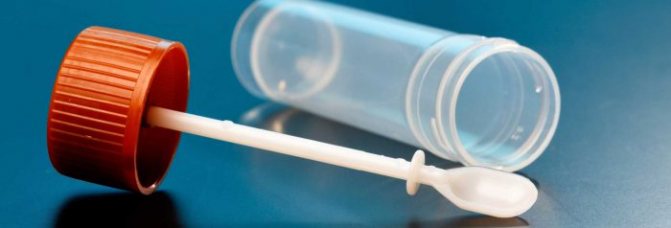
The most dangerous thing is the appearance of green stool, as this indicates the presence of staphylococcal bacillus in the intestines. They multiply quickly, and almost immediately after the appearance of frequent regurgitation, the child experiences pronounced intoxication. Greenish mucus indicates that the microflora contains coccal representatives.
To identify an infection, an infectious disease doctor prescribes a series of tests.
- Coprogram. Helps identify the cause of disorders in the gastrointestinal tract and pancreas. With its help, the condition of the digestive system is assessed.
- Analysis of stool for oviworm. Often the cause of abnormal stool is a parasite.
- Stool analysis for dysbacteriosis . Pathogenic microflora must be classified, and this study helps with this.
Additionally, a specialist may prescribe an analysis for beneficial microflora in the intestines. Due to the fact that the process of intoxication in infants is difficult and causes serious harm, assistance is provided without delay. You cannot self-medicate or purchase medications on the advice of friends or pharmacists.
Diarrhea green mucus in a child
A bacterial or viral infection provokes the appearance of some characteristic symptoms. For example, for intestinal infections, such a sign is often diarrhea with mucus in a child, and this pathology causes more severe consequences than in an adult. Therefore, it is important to act proactively and immediately seek medical help to avoid dehydration in your baby.
Causes
Many young parents are faced with such a problem as diarrhea with mucus in a child in the 1st year of the baby’s life (for some children this period lasts up to 2 years) is associated with the introduction of new unusual dishes to his menu and a gradual weaning from mother’s milk. In a one-year-old child, mucous diarrhea is, as a rule, a signal of impaired functioning of the gastrointestinal tract. In addition to a reaction to unfamiliar food, diarrhea with mucus can signal the progressive development of various pathologies.
- One of the main reasons for intestinal disorders is dysbiosis. It appears when the bacterial balance changes, when the number of harmful bacteria exceeds the content of beneficial ones.
- Diarrhea threatens children who, after a long period of fasting (or eating a small amount of food), suddenly switch to large portions of heavy food.
- Children who are breastfed react by the appearance of loose stools to changes in their mother's diet, since new products in her menu affect the composition of breast milk. This reaction is typical of very young infants, since their body is not yet strong.
- Diarrhea with mucus, but without fever, is observed in those children who suffer from lactose intolerance. It may begin after eating dairy products or food containing traces of milk.
- If sanitary standards are violated in the premises where the baby is, as well as if he or people from his social circle do not comply with the rules of personal hygiene, infection with intestinal infections is possible. Bacteria and viruses enter the body through unwashed hands and spoiled food.
- Less commonly, the cause is pathological changes in the digestive system, including congenital ones.
- Many parents of children who are going through the painful period of the appearance of their first teeth note that the child has a fever and diarrhea with mucus. This is a common symptom, however, if loose stools occur more than 5-6 times a day and in large quantities, seeking medical help should be urgent!
- Loose stools may indicate that your baby is experiencing stress. This can happen when there is a change in climate, daily routine, or experiences at the initial stage of visiting kindergarten. However, constipation is more common in these situations.
- The introduction of new products into the children's menu should be gradual. In this case, you need to follow the recommendations of pediatricians and introduce each specific product according to the age of the baby. If you do this irrationally, your fragile, delicate body will most likely react with intestinal upset.
- Diarrhea of a non-infectious breed can be a symptom of enterocolitis, gastroenteritis and damage by pathogenic microorganisms: salmonella, cryptosporidium, giardia. In this case, the intestinal tissues are damaged relatively little, so the child, as a rule, has no other complaints other than diarrhea.
So, mucus in the stool appears when the intestines get rid of “dangerous” contents along with salts, acids and alkalis.
Change in stool color
If a child has green diarrhea with mucus, this is most likely the result of poisoning. When a baby eats a low-quality product, the body first reacts with acute abdominal pain and nausea, and a little later green diarrhea begins.
This shade of stool can also appear as a result of weakening of the body after prolonged use of antibiotics. Such babies are easy prey for infections.
Diarrhea with green mucus can occur in children who have impaired enzymatic function. That is, the body secretes few enzymes to break down food. This is possible, for example, with chronic pancreatitis. Additional characteristic signs are flatulence and increased fatigue.
If the cause of diarrhea is dysentery, then in addition to green mucus, a small amount of blood may be present in the stool. Such patients are characterized by weakness, urge to vomit, and acute abdominal pain. The child is restless, rushes about, and is capricious.
Yellow diarrhea in infants and children up to one year old may be normal. But the sudden appearance and prolonged presence of such a sign may indicate the presence of rotavirus infection.
Other characteristic symptoms of this pathology: a sharp and significant increase in temperature, general malaise, vomiting.
The infection also affects the mucous membrane of the respiratory tract, so the child also develops typical signs of a respiratory disease (nasal congestion, sore throat, runny nose, cough).
Yellow diarrhea is also called “straw” diarrhea. It is provoked by an RNA virus that enters the body through airborne droplets from the person who is the carrier. This can happen, for example, if an infected patient does not wash their hands after using the toilet and touches a child or an object with which the child subsequently comes into contact.
Such an infection is dangerous due to rapid dehydration, and there is an impressive percentage of deaths. In case of effective treatment, the symptoms are eliminated and the water balance is restored. However, a young patient develops a rather unstable immunity, which increases the risk of re-infection.
Treatment, first aid
If a child develops diarrhea with mucus, it is imperative to consult a doctor as soon as possible.
It is especially important to do this without delay if we are talking about a baby. Since he is still very small, if he has profuse diarrhea, he can become dehydrated in less than a day. Delay is also fraught with the fact that pathological processes can cause irreparable harm to the health of the baby. Don't wait until the problem goes away on its own.
As first aid, it is necessary to provide the baby with plenty of fluids. You should use clean drinking water without gas and unsweetened tea. Even those children who are breastfed and who are under six months old need to be given water.
For a short time, before visiting the pediatrician, you need to limit your diet. Children rarely complain of hunger in such a situation. However, if you have an unbearable desire to eat, you can recommend crackers made from wheat bread, dry bread, and biscuits.
It should be remembered that some tablets are incompatible with each other, and instead of helping, they can only do harm. In addition, there is a risk of blurring the clinical picture of the disease and thereby making it difficult for doctors to make a correct diagnosis.
- If diarrhea is accompanied by fever, be sure to cool the child's skin with cool (not cold!) rubbing with a wet towel.
- If it is impossible to seek medical help at a particular moment, the patient should be given sorbent drugs. For example, Smecta or activated carbon.
- If the baby's diarrhea began after the introduction of complementary foods, then the new product should be discontinued. In this case, the stool will normalize on its own in the next 24 hours. However, until this moment, the baby still needs to be provided with plenty of fluids. The same is true if the nursing mother ate some unusual product. Then you should temporarily return to your previous diet.
Source: https://limto.ru/ponos-zelenaja-sliz-u-rebenka/
What to do - Dr. Komarovsky about mucus in a child’s stool
A well-known specialist in the field of pediatrics advises not to rush to conclusions if mucus impurities suddenly appear in the feces of a newborn. It is recommended to wait 2-3 days, observe the work of the baby’s digestive system, take note of which food products provoke such a reaction of the gastrointestinal tract, and only then raise the alarm. Komarovsky explains the mucus in the stool of an infant by the fact that the child’s intestines have not yet fully adapted to independent life.
In some newborns, the tissues of this digestive organ are immature to foods with a rough consistency, which are included in the diet of the first complementary foods. Therefore, Komarovsky’s opinion is that if the intestinal function of a small child does not stabilize during the first 2 days, parents need to make an appointment with a pediatrician and also get tested.
Only after this, having received the conclusions of specialists, can you find out the cause of the disease, and, if necessary, select the appropriate therapy. Self-treatment is strictly prohibited and can cause a deterioration in the baby’s well-being, even leading to even greater upset of the digestive system with the appearance of signs of diarrhea.
Similar articles:
Diarrhea with mucus in a child: causes and quick treatment
Diarrhea with mucus in a baby can indicate to parents that there is a problem in the child’s body. Responsible parents will make the right decision - consult a doctor. Moreover, if the stool is loose, frequent and accompanied by a number of other symptoms. The doctor will help determine the cause of the phenomenon. Diarrhea is not considered a disease - it is an indicator that the baby’s health is at risk.
Associated symptoms
Often, diarrhea with mucus occurs due to reasons that do not pose a threat to the child’s health. If diarrhea is caused by a chronic disease or infection, other symptoms may also occur:
- Weakness, fever;
- Blood in liquid stool;
- Green or white flakes in stool;
- Yellow, green, black diarrhea;
- Frequent loose stools – more than 10 times a day;
- Nausea, vomiting, abdominal pain.
The listed signs require immediate medical intervention, especially if present in a newborn baby.
Diseases that cause diarrhea with mucus
Certain diseases provoke loose stools with mucus, sometimes streaked with blood. Common childhood infections include:
- Salmonellosis;
- Dysentery;
- Rotavirus infection;
- Staphylococcus.
Salmonellosis
Bacterial infection acquired through dirty water or spoiled food. The disease is severe in newborns up to one year old. The child feels weak and is capricious. The temperature rises to 39 degrees.
Later, diarrhea begins. Diarrhea is frequent - more than 10 times a day. The stool has a green tint. Diarrhea contains mucus. After a week, you can see blood in the stool.
Salmonellosis is an extremely dangerous disease for children. With complications, infectious-toxic shock develops.
Dysentery
A common bacterial infection in preschool children. The incubation period lasts up to a week. Depending on the form, the disease has different symptoms and duration.
The disease begins with an increase in temperature, sometimes to critical levels. The baby has a headache. Nausea and vomiting appear. Frequent bowel movements - up to 30 times a day. The stool is liquid, mucous mixed with blood.
In severe form - transparent mucus with a green admixture.
Rotavirus infection
An intestinal infection affecting the upper respiratory tract. Most common among children from 6 months to 5 years.
In the first days after infection, there are no symptoms of the disease. Then a sign of poisoning appears - the patient feels sick and vomits.
Sometimes the disease begins like a common cold - with a cough and runny nose, without fever. Then comes abdominal pain and upset stool. At first, the urge is frequent - up to 15 times. The color of the stool is yellow, the consistency is liquid. With diarrhea, stools with a sour odor. Foam and mucus may be seen in loose stools. Later, the stool thickens and becomes grayish in color.
Dysbacteriosis
A pathology in which the intestinal microflora is disturbed. There is a predominance of harmful bacteria over beneficial ones. This condition is often observed in young children and even infants.
The disease is manifested by stool instability - alternating constipation and diarrhea. Diarrhea has an unnatural color and there is mucus in it. The patient's appetite worsens and abdominal cramps appear.
Often during diagnosis it turns out that dysbiosis is caused by another, more serious disease.
Parents' actions
Worried parents often don’t know what to do if their little child feels unwell. The first thing the mother should do is see a doctor. When the doctor listens to the complaints, performs an initial examination, prescribes treatment or gives a referral for examination to clarify the diagnosis. Before visiting the pediatrician, you need to take the following steps:
- If an older child has diarrhea with mucus, limit food intake. The recommendation does not apply to infants.
- Increase your drinking volume. Pure mineral water without carbon and herbal teas are recommended.
- It is allowed to give the baby sorbents. Smecta is suitable for little ones. Older children will take activated charcoal.
The main thing is to prevent dehydration. To replenish the water-salt balance, parents can give the child a rehydration solution purchased at the pharmacy. Closely monitor the patient's condition. Dry lips, dry skin, lack of urine – all of the above are considered signs of dehydration. If you suspect, you need to call an ambulance.
After the baby’s condition has stabilized, it is necessary to adhere to a gentle diet for some time so that the digestive system is fully restored.
Diagnosis and treatment
If mucous diarrhea does not go away after a day, the doctor prescribes a laboratory examination of the child’s biological material and a hardware examination of the gastrointestinal tract. Only after determining the cause is appropriate treatment prescribed.
Treatment
First of all, therapy is aimed at eliminating the disease that caused the intestinal disorder. If diarrhea is caused by an intestinal infection or intoxication, the doctor prescribes an antibacterial drug that eliminates the microorganism. At the same time, a probiotic is prescribed to normalize the intestinal microflora. The most frequently prescribed drugs are Bifidumbacterin, Bifiform baby, Narine.
To remove toxins, sorbents are prescribed - Polysorb, Smecta. If your baby is sick, you can give Enterosgel. Sorbents are given first when a symptom appears. Activated carbon is recommended for children over 7 years of age.
If your baby has a fever, the doctor may prescribe Panadol or children's Paracetamol.
Diet
To restore the body after diarrhea, you need a strict diet. A baby who is under 1 year of age and who is breastfed can drink breast milk at the same intervals. Breast milk will help quickly replenish fluid lost during diarrhea.
Diarrhea in a one-year-old baby and older children - you need to reduce the amount of food and increase the volume of liquid. Remove heavy and irritating foods from your diet.
Prevention
To avoid recurrent symptoms, you must adhere to simple rules:
- The child’s menu should be complete and varied, appropriate for age.
- Observe personal hygiene rules. Tell children about the need to wash their hands after going outside and to the toilet.
- Drink clean, filtered water.
- Avoid contact with sick people.
- Heat-treat vegetables and fruits.
Children's bodies are less resistant to various infections. Certain diseases that cause diarrhea with mucus can seriously affect health and even threaten life. It is important to seek medical help promptly, determine the cause and begin treatment to avoid unwanted consequences.
Source: https://GastroTract.ru/simptom/diareya/ponos-so-slizyu-u-rebyonka.html
How to diagnose pathology by the nature of stool
Although mucous inclusions are always present in stool, loose stools with mucus can only appear when there is a problem in the intestines. How to determine what is happening inside a small organism? The table below describes the main characteristics of stool and suspected problems.
We recommend: What to do in case of diarrhea and fever in a child
| The number of discharges and their nature | Presence of pathology |
| Increased mucus volume | The more discharge, the stronger the inflammatory process |
| Transparent selections | Possible enterovirus, intestinal wall inflammation |
| Green or yellow mucus | A bacterial infection has joined the inflammatory process |
| Pink slime | Indicates that there is bloody stool, or there are ulcers on the intestinal walls |
| White slime | Indicates the presence of a parasitic disease; in case of constipation, it warns of neoplasms in the intestines, for example, polyps |




